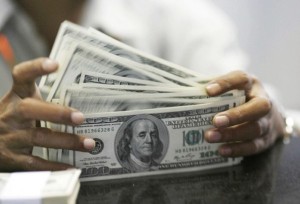Nigeria’s foreign reserve rises to $41.3 billion
 The nation’s foreign exchange rose further to $41.3 billion even as the Central Bank of Nigeria, CBN, sold $177 million at the bi-weekly Wholesale Dutch Auction System, WDAS, session.
The nation’s foreign exchange rose further to $41.3 billion even as the Central Bank of Nigeria, CBN, sold $177 million at the bi-weekly Wholesale Dutch Auction System, WDAS, session.
According to the CBN, foreign reserves rose to $41.33 billion on Tuesday from $41.186 billion at the end of last month. This represented a 0.3 per cent increase and a 26 month high when compared with its level of $38.59 billion as at August 10, 2010.
Meanwhile, the CBN sold $177 million at the WDAS session, while the naira appreciated in official market and interbank market.
Result of the WDAS showed that the official exchange rate dropped to N155.77 per dollar from N155.78 last week, representing one kobo appreciation for the naira.
At the interbank foreign exchange market, the naira gained 10 kobo following foreign exchange sales by two oil firms.
Consequently, the interbank exchange rate dropped to N157.15 per dollar from N157.25 the previous day.
On the international scene, the dollar rose against most of its major peers as investors seeking a refuge from signs of slower global growth ignored U.S. reports showing the service industries and private employment expanded more than forecast.
Australia ’s dollar slid to the least in almost a month after the nation had its widest trade deficit since 2008 and data showed China ’s services industry expanded the least in more than a year.
The euro was little changed versus the greenback after a report showed the region’s services and manufacturing shrank.
The U.S. jobless rate rose, a report may show Oct. 5. “The overall backdrop is still that of weak data around the world,” Vassili Serebriakov, a currency strategist at Wells Fargo & Co. in New York, said in a telephone interview. “There’s also probably some caution around more subdued market trends ahead of key events later this week.”
The dollar gained 0.5 percent to 78.57 yen at 11:58 a.m. New York time and touched 78.59 yen, the highest level since Sept. 19. It traded at $1.2913 per euro. The 17-nation currency advanced 0.5 percent to 101.45 yen.
Implied volatility, which signals the expected pace of currency swings, was at almost a five-year low. It was 7.80 percent, after touching 7.73 percent on Sept. 28, the least since October 2007, a JPMorgan Chase & Co. index for the currencies of Group-of-Seven nations showed. Lower volatility makes investments in currencies with higher benchmark lending rates more attractive because the risk in such trades is that market moves will erase profit.
The Dollar Index , which tracks the U.S. currency against those of six major trading partners, rose 0.2 percent to 79.899, snapping a two-day decline.
“The dollar is being bid up to some degree on the back of uncertainties that maybe perhaps be emanating from the euro zone,” said Jack Spitz, Managing Director of foreign exchange at National Bank of Canada in Toronto.
Source: Vanguard




